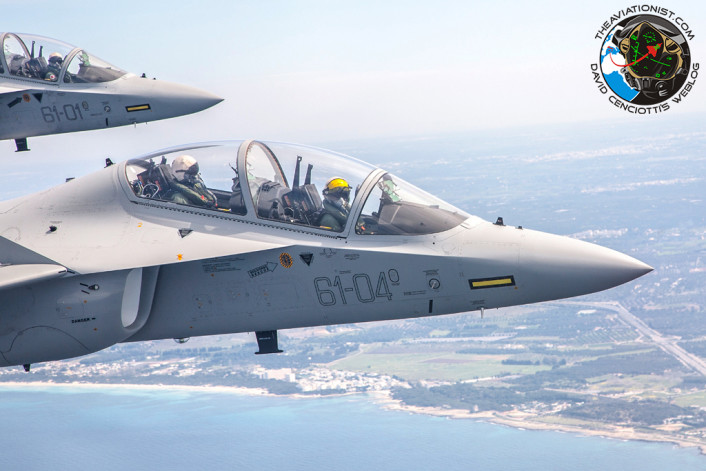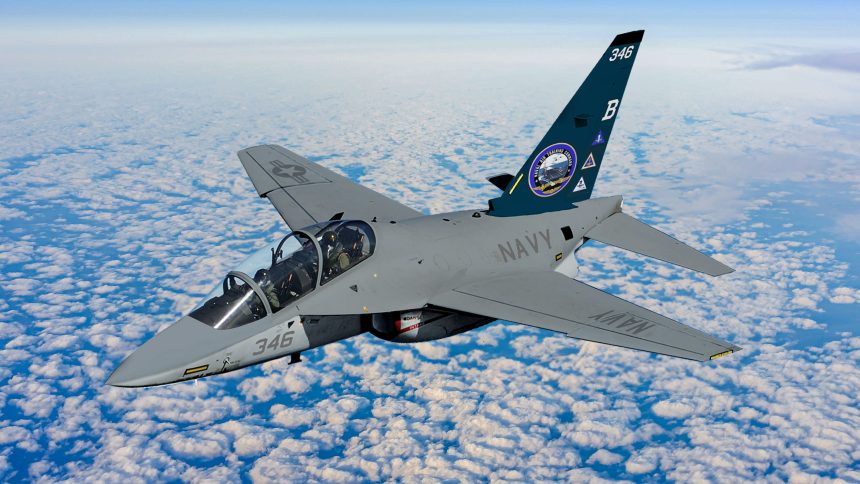We talked with Leonardo and Textron Aviation Defense, which are proposing the M-346N as replacement for the T-45 Goshawk for the U.S. Navy’s Undergraduate Jet Training System.
Textron Aviation Defense and Leonardo joined forces to pitch the Leonardo M-346N to the U.S. Navy for the program that will replace the aging T-45 Goshawk as part of the next generation Undergraduate Jet Training System (UJTS). The operationally proven aircraft is being marketed as a low risk, “ready now” solution, which could immediately fill the Navy needs as the service keeps facing problems with the T-45.
The partnership between the two companies was announced in Sept. 2023, after the U.S. Navy put out a Request for Information (RFI) for the UJTS involving the acquisition of a minimum of 145 aircraft. Other aircraft currently being proposed for the program are the Boeing-Saab T-7 and the Lockheed Martin-KAI T-50.
Both Leonardo and Textron Aviation Defense have been working in the flight training sector for a long time, with Textron specifically working with the U.S. Navy for over 70 years. Textron provided the Navy with many turboprop trainers throughout the years and, recognizing the maturity of the M-346, which efficiently trains pilots for gen 4.5 and 5th gen aircraft, is continually evolving its broad array of training aircraft to support emerging next gen needs. With the UJTS program, Textron Aviation Defense is now offering the M-346N to expand its portfolio into the jet training sector.
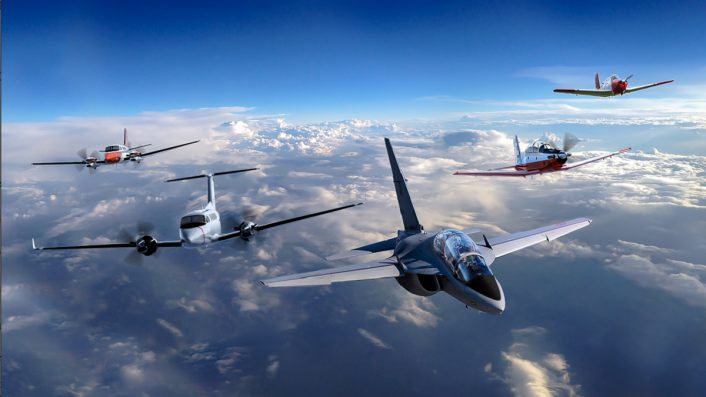
We recently had the chance to interview the Textron Aviation Defense and Leonardo team to get to know better the proposed M-346N and the work being done while waiting for the final Request for Proposals.
The Undergraduate Jet Training System program
David Kindley, Leonardo U.S.’s director for trainers, airlifters and special mission campaigns, told us that there are three overriding imperatives for modern flight training. The first one is the time required to train, as students need to go through the training command faster and thus the training needs to be more efficient and more effective.
Second one is driven by the cost to fly high-end aircraft like the F-35C and the F/A-18 Block III. The goal is to “download” the advanced training and move as much of it as possible into the training command, so it can be performed with less expensive aircraft, but without losing in training quality.
The third one is that today’s training command is changing, moving from providing “just” basic airmanship to also teaching cockpit management and processing information, which is one of the challenges that pilots face when moving to complex aircraft later on. Obviously, the Navy has some unique aspects which needs to be accounted when planning pilot training, such as carrier operations.
While pilot workload has increased for aspects like cockpit and battle management, it has decreased for some others, such as landing on the aircraft carrier. Historically, while in “the groove”, the final approach to the carrier, pilots make 200-300 corrections in just 18 seconds, so the Navy spends a lot of time to train pilots to perform this delicate maneuver with a high level of confidence.
In fact, a good portion of the training command’s syllabus is centered around the Field Carrier Landing Practice (FCLP), which allows new pilots to train on land bases for the entire approach and landing maneuver as performed on the aircraft carrier, just short of the arrested landing. The FCLPs get the pilots ready to go to the ship at sea and do “the real thing”.
Things are changing with the new Precision Landing Mode (PLM), which is now on F/A-18s and F-35s and will eventually be the standard method for approaching the aircraft carrier for all naval aircraft. With PLM, a confident aviator will make less than 20 or even less than 10 corrections in that same interval, which is a drastic difference.
One of the things that might also change in future is the availability of aircraft carriers for advanced jet pilot training. Assigning a carrier to train new pilots is a challenging and expensive task, as the training command has a lower priority compared to the primary business of the carrier, the Carrier Air Wing work-up and deployment cycle.
As of now, it appears that landing on aircraft carriers will not be included as a requirement for the new jet trainer, meaning that the aircraft will not need a tail hook and catapult launch bar. As Kindley remarked, an aircraft that has to trap on the carrier and launch from a catapult has to be designed from the ground up on that premise because the structural design needs to account for very significant stresses during carrier operations.
Even if the aircraft will not land on the carrier, it still has to perform FCLPs. The companies are working with the Navy to define the specific nature of those landings, while waiting for the final Request for Proposals (RFP) to see what the final decision on that will be and define exactly the requirements for the aircraft.
Kindley says he’s optimistic as PLM not only reduces the number of corrections while landing, but it also collapses the variation in the way the aircraft descends during the approach and landing. This could, in turn, lower the demand on the structure of the aircraft, reducing the need for structural modifications.
The M346N proposal
Thomas Webster, Textron Aviation Defense’s vice president of global sales, told us that Textron’s and Leonardo’s offer will start from the base of the current M-346 Integrated Training System already used in Italy and other nations, which will then be adapted to the Navy’s needs. This represents an advantage as the two companies will start their work with a platform that is already very well developed and only a few tweaks will be needed once the RFP comes out.
The M-346 is a mature aircraft with over 100,000 flight hours already training pilots for advanced aircraft like the F-35 and Typhoon. The M-346 Integrated Training System (ITS) is proven, with known data and very well understood engineering, so it’s a matter of little modifications to make it make it perfect for the U.S. Navy, says Webster.
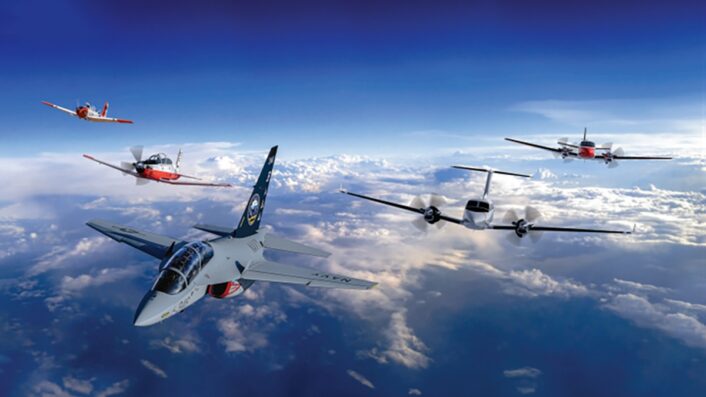
Compared to the T-100 that was proposed to the U.S. Air Force almost a decade ago before the T-7 Red Hawk was selected, the M-346 ITS kept evolving. Leonardo developed a very comprehensive system of training that’s not just the airplane anymore, says Webster, as the Live Virtual and Constructive (LVC) system allows one to go beyond what can be done with just the aircraft, challenging the student throughout the training by merging the real and virtual worlds.
According to Webster, the Navy might value and pursue such integration, as it would be a future-proof solution that would allow it to seamlessly transition from the training of gen 4.5 and 5th gen aircraft pilots to the next generations. The LVC environment would also simulate the weapon delivery and other advanced features, although the Navy has not made mention of weapon training and air refueling so far.
Another key point of the M-346N solution is that the aircraft has two engines. The T-45 is a single engine aircraft, which makes it vulnerable to bird strikes and, in fact, some aircraft have been lost because of this problem. A second engine could allow the aircraft to safely land after a bird strike.
The T-45 is also suffering engine problems and the fleet has been grounded multiple times recently. The Navy is obviously impacted by this as training is slowed down and, as Webster says, if they need to go faster than they anticipate with the replacement program, the M-346N can be a “ready now” solution if the service sends pilots to the International Flight Training School (IFTS) in Italy while the Navy’s own organic training capability is fielded.
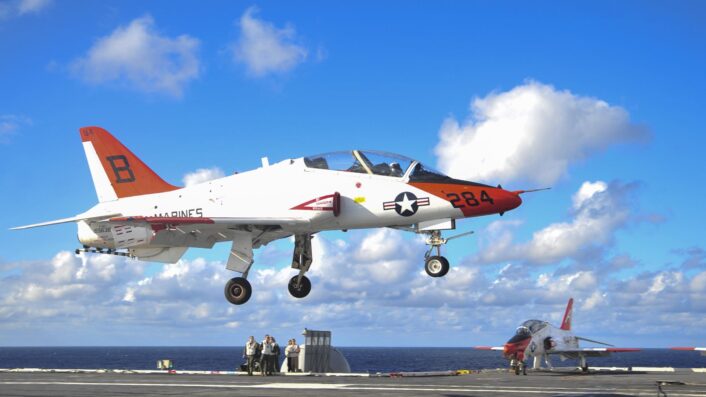
The next steps
The Navy is going to conduct an analysis of alternatives for the next few months and look at the market to see what the industry has to offer. This will allow for the preparation of a draft RFP later this year, which will then be refined and prepare the competition for the final selection.
According to the Navy budget, says Webster, in the 2026 budget there is the plan to go on contract for 10 airplanes, which is increased to 12 in 2027 and another 12 in 2028 and 2029, while a full rate production might be expected in 2030 with 25 aircraft. This means that the assessment and selection are expected to be concluded by 2026.
The Buy American Act currently says that 60% of a product must be produced in the U.S. or in a qualifying country. Not only is this requirement soon to become 75%, but Italy is considered a qualifying country thus the assembly of the aircraft in the U.S. is not mandatory. However, while waiting for the RFP, Leonardo and Textron are already having discussions to establish a final assembly line in the U.S. in a location yet to be announced.
The aircraft for the Engineering, Manufacturing and Development (EMD) phase will likely be produced in Venegono, where the M-346s are presently built, before transitioning part of the line to the United States. Personnel from Textron have visited Leonardo’s plant in Venegono to get a better understanding of how the aircraft is produced.
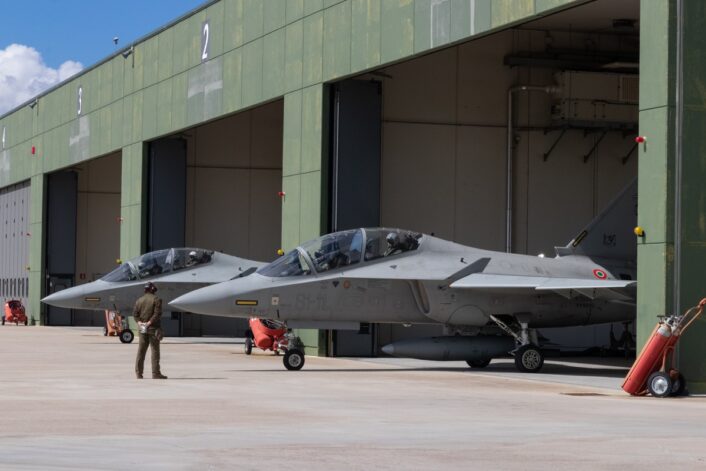
The two companies aim to give the Navy a cost-effective platform in the least amount of time, so engineering work is already started and is making good progress, allowing the team to shorten the future EMD phase. Work is already ongoing to integrate the PLM in the M-346N and the team has had some very successful initial looks at putting that into the airplane, says Webster.
Webster says that the requirement for a Large Area Display (LAD) in the cockpit is expected in the RFP, so engineering is ongoing also for that. The Navy already employs LADs on the F-35C and F/A-18 Block III aircraft that would be flown by pilots graduated on the M-346N.
As the competitors await the Navy’s definition of the specific nature of the FCLPs, Textron Aviation Defense and Leonardo are collaborating on the engineering already in progress to verify the aircraft can sustain a high number of FCLPs and are investigating the possible need for minor structural and landing gear modifications. Since the Navy’s number of required FCLPs is not yet finalized and could fluctuate before the final RFP, the team is well-poised to act quickly in support of the Navy’s evolving needs.
In the end, Textron and Leonardo say the M-346N is the U.S. Navy’s only “low risk no drama solution”.
A test pilot’s perspective
During our interview we also had a chance to talk with Steven Helmer, a Naval Aviator, U.S. Naval Test Pilot School Graduate and now a test and demonstration pilot for Textron Aviation Defense & Special Missions. Helmer, although he has not yet flown the M-346, flew on several engineering development simulators in Italy at IFTS and in Venegono and says he’s impressed by the entire M-346 ITS.
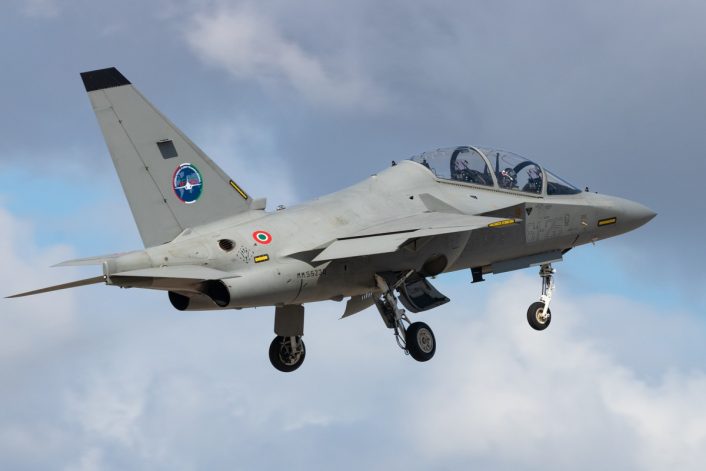
One of the aspects he was most impressed by is how receptive the airplane is to the engineering updates and the software changes to implement PLM. Helmer also mentions how the M-346’s performance is much closer to a modern combat aircraft, compared to the T-45, and has the kinematics to match what a modern fighter pilot needs to see in training.
“The aircraft performs exceptionally, similar to a gen. 4- or 5-type fighter”, he said.
Helmer firmly believes that the M-346N can take the U.S. Navy’s training to the next level, moving the fundamental training flights currently performed during F/A-18 and F-35 training from the Fleet Replacement Squadrons to the advanced jet training. By leveraging the vertical integration with LVC, avionics and the overall training system with aircraft, simulator and ground-based training systems, fundamental training can be performed at much lower cost and without wearing out those fleet aircraft as quickly.
